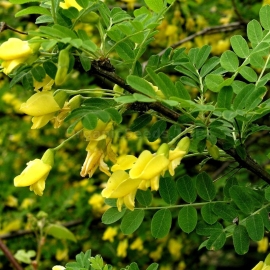




Siberian peashrub Seeds (Caragana arborescens)
1.14 €
Caragana arborescens, or Caragana or Siberian peashrub or Siberian peashrub, is a species of legume. It is a shrub growing to heights of 12 feet or more and is a perennial. Typically, it has a moderate to fast growth rate.
-
Siberian peashrub / (Caragana arborescens)
Caragana arborescens, or Caragana or Siberian peashrub or Siberian peashrub, is a species of legume. It is a shrub growing to heights of 12 feet or more and is a perennial.
Typically, it has a moderate to fast growth rate, being able to grow one to three feet during the first year after trimming. The plant is native to Siberia and parts of China and neighboring Mongolia and Kazakhstan. It is commonly grown throughout the northern hemisphere as a landscaping plant and ornamental.
Extremely hardy - a plant lifted from a pot in December spent the winter in zone 5 with its bare rootball frozen to the turf-still bloomed well in the spring; bright yellow flowers in spring; small bright green compound leaves.
The whole plant, known as ning tiao, is used in the treatment of cancer of the breast, and the orifice to the womb, and for dysmenorrhoea and other gynaecological problems.
Windbreaks - The caragana is recommended for planting in the outer rows of multi-row plantings. It can be used to neutralize soil to prepare for further planting. A legume, the caragana fixes nitrogen. It is suitable for planting in single-row field windbreaks where a dense, short barrier is desired.
Wildlife habitat - The caragana is used for nesting by several songbirds. The seeds are occasionally eaten by a few songbirds. The plant is not a preferred food for browsing animals, but its fragrant flowers attract many pollen-consuming animals.
Erosion control - The caragans has an extensive root system that can be used to assist with erosion control.
Ornamental - The caragana, with its small fragrant flowers and attractive compound leaflets, is used alongside lilacs to create a 'compare and contrast' appearance.
Bee plants - The caragana has a fragrant flower that naturally will attract bees. The honey created has a pleasant taste, slightly 'fruity'.
Cultivated food source - The caragana has a slightly bitter tasting 'pea', usually 3-4 to a pod, that is edible. They should be cooked before eaten. There have been no verified cases of poisoning from consuming the caragana pea. Additionally, the yellow flowers which have a taste like peas, can be used in salads to add colour and some flavour.
Bonsai Trees - make delightful bonsai medium to large size and have year round interest, from bark to stems to flowers and fruit pods.How to Grow
Although these seeds have only a very shallow dormancy they have a hard seed coat and require pretreatment for successful germination to occur. Without pretreatment it is likely that 10% or less of the seeds will germinate. A combination of a variety of seed pretreatments is usually necessary to make the seed coat permeable so that the seed embryo can take up water and begin to germinate.
The first (and easiest) method is place the seeds in a container and pour warm (not boiling!) water over them and leave them to soak for between 12-24 hours. Seeds that have been successfully pretreated will have swollen to around 2-3 times their previous size. Remove all swollen seeds as these will be damaged by further pretreatments. These can be sown immediately. This warm water treatment can be repeated up to 3 times, making the water a little hotter each time. Seeds that remain small need to be dried for further treatment.
Seeds that have swelled should be ready to germinate and will take 3-4 weeks in temperatures of 20 Celsius. Seed that have not taken up water can be cold stratified for up to around 4 weeks. To do this mix the seeds with a small amount of 50/50 compost and sharp sand -this must be moist but not enough to be able to squeeze out water with your hand. Put the mixture of seeds and compost in a loosly tied freezer bag and place in the fridge for 4 weeks. After this time the seeds are ready for sowing.
Sow in pots or seed trays of good quality compost at a depth of about 1cm (just less than 1/2 inch) The seed usually germinates in under 4 weeks at 15-20°c. Gerination and growth are usually pretty quick and plants may grow to between 15 and 45cm (6-18 inches) during their first season. Plant them out into their permanent positions in late summer if they have made sufficient growth, otherwise during the following year.
